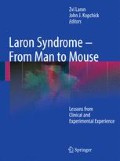Core Message
The hair of patients with Laron syndrome grows slowly and shows pathological features on electron microscopy. Young adults have sparse hair to alopecia.
The skin is thin and on histological examination shows changes in the elastin fibers. The appearance of acne is dependent on the sex hormone concentrations and the latter on the IGF-I dose during treatment.
Access this chapter
Tax calculation will be finalised at checkout
Purchases are for personal use only
References
Abramovici A, Josefsberg Z, Mimouni M, Liban E, Laron Z (1983) Histopathological features of the skin in hypopituitarism in Laron type dwarfism. Isr J Med Sci 19:515–519
Bean WB (1980) Nail growth. Thirty-five years of observation. Arch Intern Med 140:73–76
Ben-Amitai D, Laron Z (2010) Effect of insulin-like growth factor-1 (IGF-1) deficiency or administration on the occurrence of acne. J Eur Acad Dermatol Venerol (in press)
Blume-Peytavi U, Orfanos CE (1995) Microscopy of the hair. In: Seruo J, Jemec GBE (eds) Handbook of non-invasive methods and the skin. CRC Press, Boca Raton, pp 549–555
Hogan PA (2006) Cutaneous manifestations of endocrine disease. In: Harper J, Orange A, Prose N (eds) Textbook of pediatric dermatology, vol 2. Blackwell, Malden, MA, pp 1–2013
Itami S, Kurata S, Sonoda T, Takayasu S (1995) Interaction between dermal papilla cells and follicular epithelial cells in vitro: effect of androgen. Br J Dermatol 132:527–532
Klinger B, Jensen LT, Silbergeld A, Laron Z (1996) Insulin-like growth factor-I raises serum procollagen levels in children and adults with Laron syndrome. Clin Endocrinol 46:423–429
Laron Z (1969) The hypothalamus and the pituitary gland (hypophysis). In: Hubble D (ed) Paediatric endocrinology. Blackwell Scientific Publications, Oxford, p 76
Laron Z (2004) Laron syndrome (primary growth hormone resistance or insensitivity). The personal experience 1958-2003. J Clin Endocrinol Metab 89:1031–1044
Laron Z (2008) Insulin-like growth factor-I treatment of children with Laron syndrome (primary growth hormone insensitivity). Pediatr Endocrinol Rev 5:766–771
Laron Z, Pertzelan A, Karp M (1968) Pituitary dwarfism with high serum levels of growth hormone. Isr J Med Sci 4:883–894
Liu JP, Baker J, Perkins AS, Robertson EJ, Efstratiadis A (1993) Mice carrying null mutations of the genes encoding insulin-like growth factor I (IGF-1) and type 1 IGF receptor (IGF-1r). Cell 75:59–72
Lurie R, Ben-Amitai D, Laron Z (2004) Laron syndrome (primary growth hormone insensitivity): a unique model to explore the effect of insulin-like growth factor 1 deficiency on human hair. Dermatology 208:314–318
Melmed S, Kleinberg D (2003) Anterior pituitary. In: Larsen PR, Kronenberg HM, Melmed S, Polonsky KS (eds) Williams textbook of endocrinology, 10th edn. Saunders/Elsevier, Philadelphia, p 235
Peus D, Pittelkow MR (1996) Growth factors in hair organ development and the hair growth cycle. Dermatol Clin 14:559–572
Philpott MP, Sanders DA, Kealey T (1994) Effects of insulin and insulin-like growth factors on cultured human hair follicles: IGF-I at physiologic concentrations is an important regulator of hair follicle growth in vitro. J Invest Dermatol 102:857–861
Randall VA (2007) Hormonal regulation of hair follicles exhibits a biological paradox. Semin Cell Dev Biol 18:274–285
Randall VA (2008) The endocrine control of the hair follicle. In: Blume-Peytavi U, Tosti A, Whiting DA, Trueb RM (eds) Hair growth and disorders. Springer, Berlin-Heidelberg, pp 23–39
Stenn KS, Combates NJ, Eilertsen KJ, Gordon JS, Pardinas JR, Parimoo S, Prouty SM (1996) Hair follicle growth controls. Dermatol Clin 14:543–558
Tavakkol A, Elder JT, Griffiths CE, Cooper KD, Talwar H, Fisher GJ, Keane KM, Foltin SK, Voorhees JJ (1992) Expression of growth hormone receptor, insulin-like growth factor 1 (IGF-1) and IGF-1 receptor mRNA and proteins in human skin. J Invest Dermatol 99:343–349
Author information
Authors and Affiliations
Corresponding author
Editor information
Editors and Affiliations
Rights and permissions
Copyright information
© 2011 Springer Berlin Heidelberg
About this chapter
Cite this chapter
Laron, Z. (2011). Hair, Skin, and Nails in Patients with Laron Syndrome. In: Laron, Z., Kopchick, J. (eds) Laron Syndrome - From Man to Mouse. Springer, Berlin, Heidelberg. https://doi.org/10.1007/978-3-642-11183-9_24
Download citation
DOI: https://doi.org/10.1007/978-3-642-11183-9_24
Published:
Publisher Name: Springer, Berlin, Heidelberg
Print ISBN: 978-3-642-11182-2
Online ISBN: 978-3-642-11183-9
eBook Packages: MedicineMedicine (R0)

